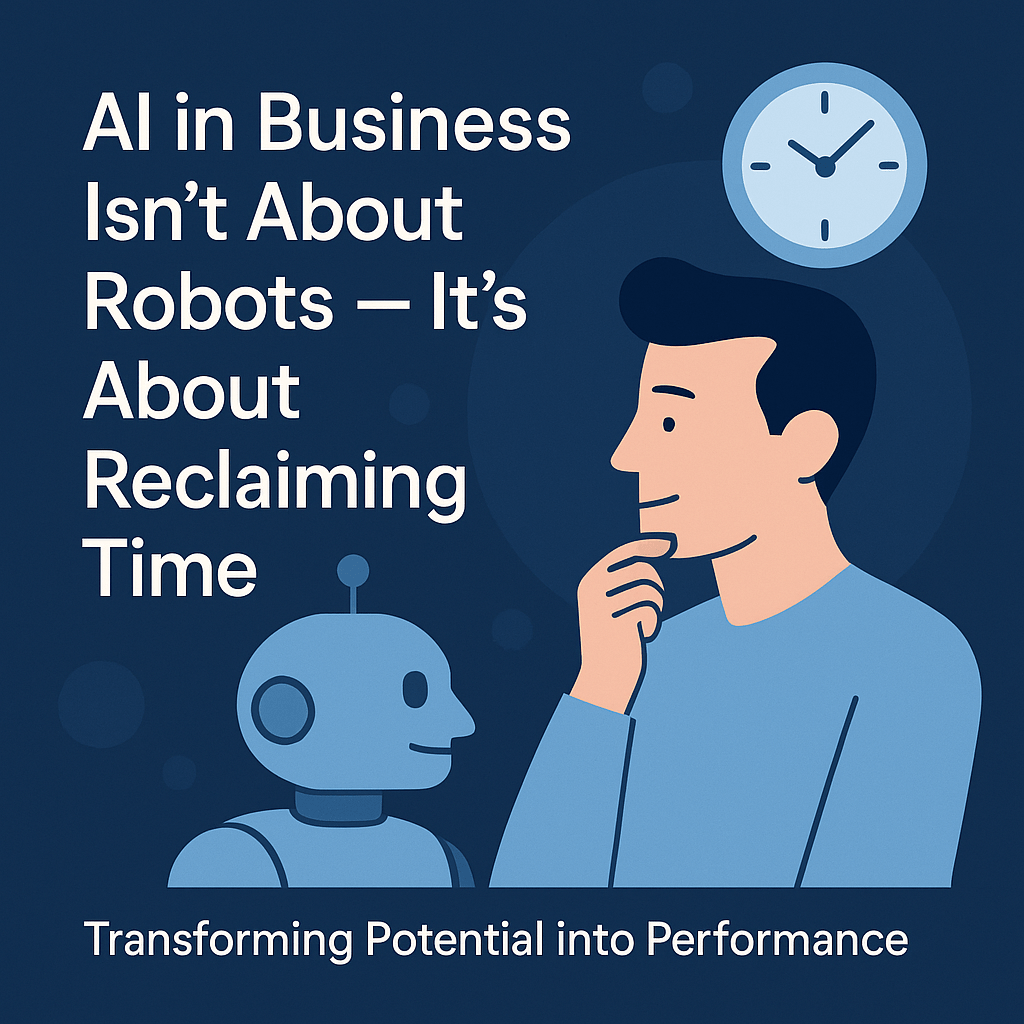
When most people think of AI in business, they picture robots, automation and futuristic systems replacing human workers. It’s a common misconception and one that’s often fuelled by hype-driven headlines or flashy product demos. But in practice, that’s not where the real value of AI lies for most businesses.
The real advantage of AI isn’t about replacing people. It’s about reclaiming time, reducing friction and freeing up energy to focus on the work that actually moves the business forward. In an age of growing demands and shrinking attention, AI offers something many teams desperately need: breathing space.
From Automation to Amplification
Despite how it’s often marketed, AI in business is not about eliminating jobs or dehumanising operations. It’s about reducing the repetitive and reactive work that eats away at productivity and morale.
Think about how much time is lost every week drafting the same kinds of emails, writing first-pass reports, summarising meetings or pulling together fragmented notes. According to a recent study by Asana*, the average knowledge worker spends 58% of their time on “work about work.” Switching between apps, chasing updates, duplicating tasks and generally treading water to stay afloat.
That’s where AI can make a meaningful difference.
By handling lower-value, repeatable tasks like summarising conversations, drafting content, tagging support tickets or automating parts of internal workflows. AI doesn’t eliminate human input, it amplifies it. Your team gets time back to think more clearly, execute more deliberately and focus on higher-impact work.
It’s Not Just About Efficiency, It’s About Headspace
Time savings aren’t just a matter of hours gained. They’re also about reducing mental load.
One of the biggest challenges for founders, team leads and scale-up operators is context switching. You move from a budget meeting to a customer issue, then to a hiring conversation and then onto a product roadmap review often in the same hour. Each one demands different focus, tone and mental energy.
When used well, AI in business reduces the constant grind of decision fatigue. It helps teams prioritise better, catch issues earlier and avoid the burnout that comes from trying to hold everything in your head at once. The time you reclaim isn’t just for doing more, it’s for thinking better.
Where AI in Business Is Already Reclaiming Time and Focus
Across industries, AI is already being used to support smart business practices. Not by replacing humans, but by supporting them. Some practical examples include:
- Customer support: AI triages tickets, suggests responses and escalates more effectively, allowing human agents to focus on complex, high-empathy conversations.
- Marketing & communications: Teams use AI to generate content drafts, perform research and repurpose existing assets, reducing creation time and unlocking capacity.
- Operations & admin: Meeting summaries, task follow-ups and resource management are increasingly supported by tools that streamline routine processes.
- Data insights: AI analyses customer feedback, sales data or usage patterns to surface trends and support better, faster decision-making.
These are not theoretical gains, they’re happening right now. In fact, a McKinsey report* found that businesses using AI tools effectively are seeing productivity increases of up to 40% in targeted functions, especially where repetitive tasks are high.
Use AI as a Lever, Not a Crutch
Of course, AI isn’t a silver bullet. It won’t fix broken processes or create vision where none exists. But when used intentionally as part of a broader strategy, it can become a powerful lever for change.
The key is to treat it as a supporting tool, not a substitute for good leadership, sound thinking or clear direction. Businesses that lead with strategy and then apply AI to help scale their efforts are the ones that benefit most. Those that jump on the tech without clarity often end up creating more chaos, not less.
The Bottom Line
AI in business isn’t about science fiction. It’s about freeing up space to do better work.
It’s about allowing your team to shift from busywork to meaningful impact. To stop spinning their wheels and start moving with purpose.
If you’re exploring where AI could add value in your business, don’t start by asking what tools you need. Start by asking: What would we do better if we had more time and focus?
AI might just help you reclaim both.
Want to Explore AI in Business Without the Overwhelm?
If you’re curious about how AI in business could reduce friction and give your team more room to breathe without the hype or overengineering, I’d be happy to help.
→ Reach out here for an informal conversation about where to begin
→ And stay tuned, I’ll be sharing more guidance on this over the coming months
*Sources
- Asana: Anatomy of Work Index 2021
- McKinsey & Co: The State of AI in 2023
